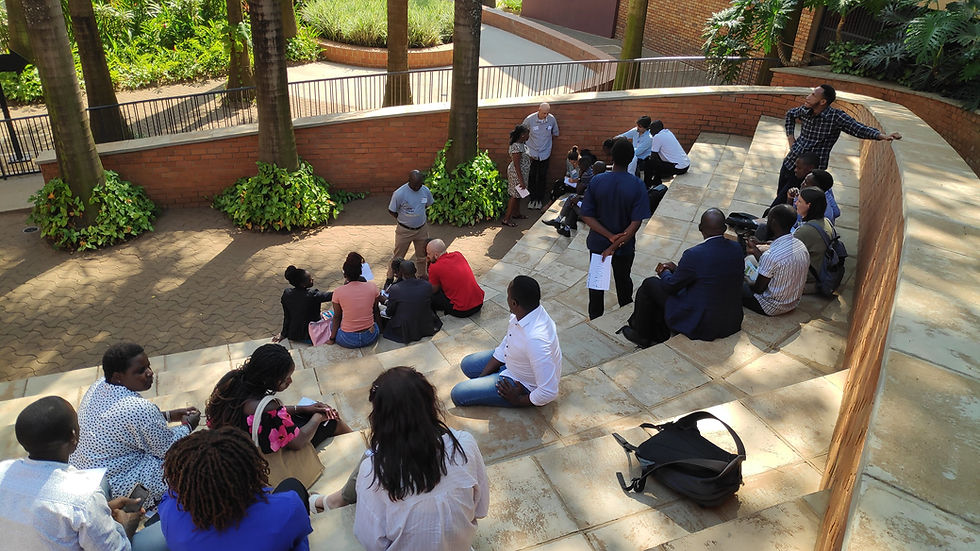Building schools is one big compromise
- info8381132
- Jul 31, 2024
- 3 min read
Updated: Aug 1, 2024
Meg Collin, Field Officer
Last month a team from the Feilden Foundation, Buro Happold and Grants Associates headed out to Kampala for a conference on sustainable schools design. Hosted by the Belgian Development Agency, Enabel, it brought together policymakers, designers and educators to learn about the design of educational facilities in the region, culminating in the launch of the draft East Africa School’s Design Guide.

Launching the draft guide with H.E the Ambassador of the Kingdom of Belgium, Hugues Chantry and MoES Commissioner for Secondary Education, Muzoora Juliet.
We heard from experts in landscape design, and accessibility; from those running schools and students just graduating. There were sessions on bringing Active Teaching and Learning into the classroom, and on how local communities of practice can strengthen teachers. The Ugandan Ministry of Education (MoES) expressed their overwhelming support for the conference and design guidance, shared the struggles facing their country and talked about measures they are putting in place to improve accessibility and inclusion, amongst other things. MINEDUC explained the pioneering ways they are using technology to elevate the standard of education in Rwanda, despite limited resources.
There was a real buzz about the room as ideas were shared, new contacts established, and resolves made. The air was filled with a sense of optimism that educational infrastructure, both in buildings and teaching, is on the cusp of systemic change for the better.

Several architecture students displayed their graduation projects, many of which were of innovative solutions at educational facilities.
The scale of the challenge, however, is huge. There are an estimated 210 million school-age children across East Africa (55% of the population)– facing multiple barriers to education. In Uganda alone, in order for all primary school age children from the expanding population to be taught in classes of 45, there is a need for over 160,000 new classrooms in the next 5 years, and the teachers to go with them. That’s 615 a week.
There is clear consensus on the need to increase educational capacity, but there are several competing priorities. We are facing a global climate emergency, rapid urbanisation on an unprecedented scale, and need to meet the needs of all children.

It’s not uncommon to have over 80 students in a class which impacts both teaching and learning.
How can we justify paying up to 50% extra to build using more sustainable materials, if this means only six classrooms can be built, instead of nine? On the other hand, how can we justify using low-cost ‘village bricks’ which are made by burning illegally logged timber from a nearby forest, which in turn will cause environmental and economic suffering for the community in years to come?
Is it better to invest in the external landscape of a school – a cost-effective way of creating extra learning spaces, but one with connotations of regression - or to invest in new IT facilities in spite of irregular power supplies and the potential for theft?

Use of trees and local materials for hard-landscaping creates gathering spaces for learning and socialising. © Tim Latim
Significant time and energy is being spent working out where savings can be made, for example by reducing the concrete usage of large drainage ditches; in rationalising multi-storey ramps; or in developing prefabricated solutions which result in an affordable, sustainable structure – such as those being tested by our Ugandan collaborator, Localworks. More localised solutions may emerge as country-specific guidance is developed as addendums to the base guidelines.
The final session of the conference was a time for group discussion and feedback. This enabled attendees to share what they had learned from the conference, while also giving critical input and advice on the draft Schools Design Guide. The feedback received is insightful and will help us as we finalise the Guide over the coming months – covering issues of policy, implementation and local contextualisation.

The group feedback session at the conference, in the grounds of Kampala International School Uganda.
In this discussion time, after all that had been said and heard, one group summarised:
‘Building schools is one big compromise.’
I couldn’t agree more. There is no silver bullet that will fix everything, change will not happen overnight and the resource constraints are a seriously limiting factor. Conferences like this play a crucial role in bringing together stakeholders to work together, understand the different issues and to devise solutions that, imperfect though they will be, offer the best outcomes for the millions of children going through education both now and in the future.

Comentários